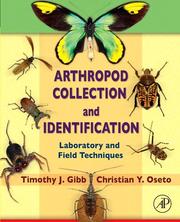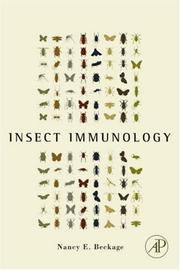| Listing 1 - 10 of 65 | << page >> |
Sort by
|

ISBN: 1281795372 9786611795375 0080919251 9780080919256 9780123695451 0123695457 9781281795373 6611795375 Year: 2006 Publisher: Amsterdam Boston Academic Press
Abstract | Keywords | Export | Availability | Bookmark
 Loading...
Loading...Choose an application
- Reference Manager
- EndNote
- RefWorks (Direct export to RefWorks)
Arthropods are the most numerous and diverse group of animals and studying them requires the use of specialized equipment and specific procedures. This text describes effective methods and equipment for collecting, identifying, rearing, examining, and preserving insects and mites, and explains how to store and care for specimens in collections. It also provides instructions for the construction of many kinds of collecting equipment, traps, rearing cages, and storage units, as well as updated and illustrated keys for identification of the classes of arthropods and the orders of insects. Such
Arthropoda --- Arthropods --- Bilateria --- Invertebrates --- Collection and preservation.
Book
ISBN: 9780128030066 0128030062 9780128029961 012802996X 9780128099346 0128099348 Year: 2016 Publisher: Amsterdam, [Netherlands] : Academic Press,
Abstract | Keywords | Export | Availability | Bookmark
 Loading...
Loading...Choose an application
- Reference Manager
- EndNote
- RefWorks (Direct export to RefWorks)
Chordata --- Evolution. --- Chordate animals --- Chordates --- Bilateria

ISBN: 1281111902 9786611111908 0080556337 0123739764 9780123739766 9780080556338 Year: 2008 Publisher: Amsterdam Boston Academic Press
Abstract | Keywords | Export | Availability | Bookmark
 Loading...
Loading...Choose an application
- Reference Manager
- EndNote
- RefWorks (Direct export to RefWorks)
This work is the first book-length publication on the topic of insect immunology since 1991, complementing earlier works by offering a fresh perspective on current research. Interactions of host immune systems with both parasites and pathogens are presented in detail, as well as the genomics and proteomics, approaches which have been lacking in other publications. Beckage provides comprehensive coverage of topics important to medical researchers, including Drosophila as a model for studying cellular and humoral immune mechanisms, biochemical mediators of immunity, and insect blood cells and th
Insects --- Arthropoda --- Immunology. --- Arthropods --- Hexapoda --- Insecta --- Pterygota --- Bilateria --- Invertebrates --- Entomology
Book
ISBN: 1283851822 9004188266 9789004188266 9789004156111 9004156119 9781283851824 Year: 2011 Publisher: Leiden Boston Brill
Abstract | Keywords | Export | Availability | Bookmark
 Loading...
Loading...Choose an application
- Reference Manager
- EndNote
- RefWorks (Direct export to RefWorks)
Myriapods are the only major zoological group for which a modern encyclopedic treatment has never been produced. In particular, this was the single major gap in the largest zoological treatise of the XIX century (Grassé’s Traité de Zoologie), whose publication has recently been stopped. The two volumes of “The Myriapoda” fill that gap with an updated treatment in the English language. Volume I opens with an introductory treatment of myriapod affinities and phylogeny. The following chapters are mostly devoted to the Chilopoda or centipedes, extensively treated from the point of view of external and internal morphology, physiology, reproduction, development, distribution, ecology, phylogeny and taxonomy. All currently recognized suprageneric and generic taxa are considered. Additional chapters deal with the two smaller myriapod classes, the Symphyla and the Pauropoda. All groups and features are extensively illustrated by line drawings and micrographs and living specimens of representative species of the main groups are presented in color photographs.
Myriapoda. --- Arthropoda. --- Arthropods --- Myriapods --- Myriopoda --- Myriopods --- Bilateria --- Invertebrates --- Arthropoda
Book
ISBN: 0128135085 0128024410 9780128135082 9780128024416 9780128024416 Year: 2018 Publisher: London
Abstract | Keywords | Export | Availability | Bookmark
 Loading...
Loading...Choose an application
- Reference Manager
- EndNote
- RefWorks (Direct export to RefWorks)
Tomatoes --- Arthropoda --- Diseases and pests. --- Control. --- Arthropods --- Bilateria --- Invertebrates
Book
ISBN: 168108225X 9781681082257 9781681082264 Year: 2016 Publisher: Sharjah, U.A.E.
Abstract | Keywords | Export | Availability | Bookmark
 Loading...
Loading...Choose an application
- Reference Manager
- EndNote
- RefWorks (Direct export to RefWorks)
Mollusks. --- Conchology --- Malacology --- Mollusca --- Molluscs --- Bilateria --- Invertebrates --- Shellfish
Book
ISBN: 0128186216 0128196998 9780128196991 9780128186213 Year: 2022 Publisher: London San Diego, CA
Abstract | Keywords | Export | Availability | Bookmark
 Loading...
Loading...Choose an application
- Reference Manager
- EndNote
- RefWorks (Direct export to RefWorks)
Field crops --- Arthropoda. --- Diseases and pests. --- Arthropods --- Bilateria --- Invertebrates
Book
ISBN: 1838801960 1838801952 1838806474 Year: 2019 Publisher: IntechOpen
Abstract | Keywords | Export | Availability | Bookmark
 Loading...
Loading...Choose an application
- Reference Manager
- EndNote
- RefWorks (Direct export to RefWorks)
This book is divided into four sections. The first section ""Introduction"" offers information on mollusc generalities. In addition, these organisms are important in areas of commercial significance such as aquaculture and fishing. Similarly, it was pointed out in the use of molluscs have uses in pollution studies and environmental processes among others. The second section ""Social Aspects of Fisheries"" considers aspects of molluscs gathering in tropical regions. The third section ""Ecology"" presents the results of long-term research concerning the study of variability of the size/mass relationships in the mollusc Rapana venosa from the northwestern part of the Black Sea and near the eastern coast of Crimea (Sudak Gulf). The fourth section ""Immune System"" sheds light on the elements of the molluscan immune system and survival differences against Vibrio vulnificus and Vibrio parahaemolyticus. This book can be consulted by students, professors, and researchers in biological sciences and related areas.
Mollusks. --- Conchology --- Malacology --- Mollusca --- Molluscs --- Bilateria --- Invertebrates --- Shellfish --- Life Sciences --- Animal Biology --- Agricultural and Biological Sciences
Book
ISBN: 1608054012 9781608054015 Year: 2012 Publisher: [Dubai, United Arab Emirates] Bentham eBooks
Abstract | Keywords | Export | Availability | Bookmark
 Loading...
Loading...Choose an application
- Reference Manager
- EndNote
- RefWorks (Direct export to RefWorks)
This e-book elucidates the physiological role, both at biochemical and molecular levels, of hemolymph proteins and functional peptides in reproduction, development, homeostasis, hibernation, migration, immune system, and in abiotic stress tolerance of insects and other arthropods.
Arthropoda. --- Hemolymph. --- Peptides --- Organic compounds --- Amino acids --- Haemolymph --- Blood --- Lymphatics --- Arthropods --- Bilateria --- Invertebrates --- Physiological effect.
Book
ISBN: 3110274272 3110385562 9783110274271 9783110273816 9783110385564 Year: 2015 Publisher: Berlin [Germany] Munich [Germany] Boston [Massachusetts]
Abstract | Keywords | Export | Availability | Bookmark
 Loading...
Loading...Choose an application
- Reference Manager
- EndNote
- RefWorks (Direct export to RefWorks)
This section of the Handbook of Zoology is intended as a comprehensive and exhaustive account of the biology of the taxa Gastrotricha, Nematoda, Nematomorpha, Priapulida, Kinorhyncha, Loricifera, Gnathostomulida, Micrognathozoa, Rotifera, Seisonida and Acanthocephala, covering all relevant topics such as morphology, ecology, phylogeny and diversity. The series is intended to be a detailed and up-to-date account of these taxa. As was the case with the first edition, the Handbook is intended to serve as a reliable resource for decades. Many of the taxa of this volume are comparatively unknown to many biologists, despite their diversity and importance for example in meiofaunal communities (Gastrotricha, Rotifera, Gnathostomulida), their fascinating recent discoveries (Loricifera and Micrognathozoa), their importance as parasites (many nematodes, Nematomorpha, Acanthocephala) and their importance for evolutionary questions (e.g. Priapulida, Gastrotricha). The groups covered range from those poor in species (such as Micrognathozoa with 2 known species) to the species-rich and diverse Nematoda and their ca. 20.000 described species. While each taxon is covered by one chapter, nematodes are treated in several chapters dedicated to their structural, taxonomic and ecological diversity.
Worms --- Vermes --- Vermiform animals --- Bilateria --- Invertebrates --- Phylogeny. --- Morphology. --- Nemotode. --- Parasite. --- Zoological Systematics. --- Zoology.
| Listing 1 - 10 of 65 | << page >> |
Sort by
|

 Search
Search Feedback
Feedback About UniCat
About UniCat  Help
Help News
News